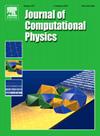A mesh-constrained discrete point method for incompressible flows with moving boundaries
IF 3.8
2区 物理与天体物理
Q2 COMPUTER SCIENCE, INTERDISCIPLINARY APPLICATIONS
引用次数: 0
Abstract
Particle-based methods are a practical tool in computational fluid dynamics, and novel types of methods have been proposed. However, widely developed Lagrangian-type formulations suffer from the nonuniform distribution of particles, which is enhanced over time and result in problems in computational efficiency and parallel computations. To mitigate these problems, a mesh-constrained discrete point (MCD) method was developed for stationary boundary problems (Matsuda et al., 2022). Although the MCD method is a meshless method that uses moving least-squares approximation, the arrangement of particles (or discrete points (DPs)) is specialized so that their positions are constrained in a background mesh to obtain a closely uniform distribution. This achieves a reasonable approximation for spatial derivatives with compact stencils without encountering any ill-posed condition and leads to good performance in terms of computational efficiency. In this study, a novel meshless method based on the MCD method for incompressible flows with moving boundaries is proposed. To ensure the mesh constraint of each DP in moving boundary problems, a novel updating algorithm for the DP arrangement is developed so that the position of DPs is not only rearranged but the DPs are also reassigned the role of being on the boundary or not. The proposed method achieved reasonable results in numerical experiments for well-known moving boundary problems.
移动边界不可压缩流的网格约束离散点法
基于粒子的方法是计算流体动力学中的一种实用工具,并且已经提出了新的方法类型。然而,广泛发展的拉格朗日型公式存在粒子分布不均匀的问题,这种问题随着时间的推移而增强,并导致计算效率和并行计算方面的问题。为了缓解这些问题,针对平稳边界问题开发了网格约束离散点(MCD)方法(Matsuda et al., 2022)。虽然MCD方法是一种使用移动最小二乘近似的无网格方法,但粒子(或离散点(DPs))的排列是专门的,因此它们的位置在背景网格中受到约束,以获得紧密均匀的分布。该方法在不遇到任何病态条件的情况下,实现了紧凑模板空间导数的合理逼近,在计算效率方面取得了良好的性能。本文提出了一种基于MCD方法的移动边界不可压缩流的无网格计算方法。为了保证移动边界问题中每个DP的网格约束,提出了一种新的DP排列更新算法,不仅重新排列DP的位置,而且重新分配DP在边界上或不在边界上的角色。该方法在著名的移动边界问题的数值实验中取得了较好的结果。
本文章由计算机程序翻译,如有差异,请以英文原文为准。
求助全文
约1分钟内获得全文
求助全文
来源期刊

Journal of Computational Physics
物理-计算机:跨学科应用
CiteScore
7.60
自引率
14.60%
发文量
763
审稿时长
5.8 months
期刊介绍:
Journal of Computational Physics thoroughly treats the computational aspects of physical problems, presenting techniques for the numerical solution of mathematical equations arising in all areas of physics. The journal seeks to emphasize methods that cross disciplinary boundaries.
The Journal of Computational Physics also publishes short notes of 4 pages or less (including figures, tables, and references but excluding title pages). Letters to the Editor commenting on articles already published in this Journal will also be considered. Neither notes nor letters should have an abstract.
 求助内容:
求助内容: 应助结果提醒方式:
应助结果提醒方式:


